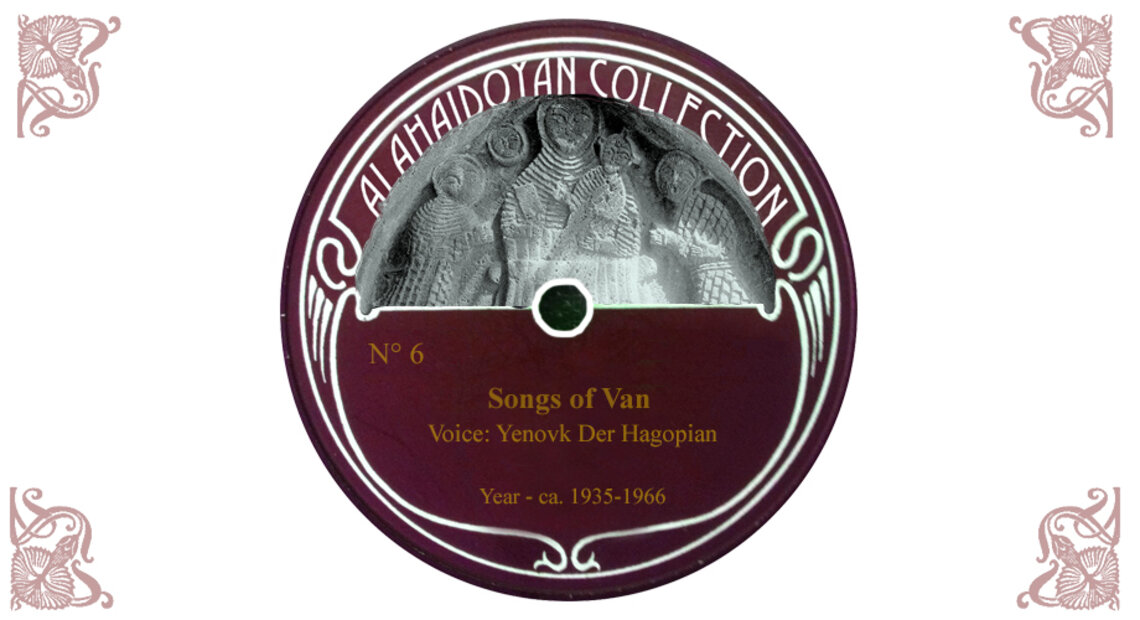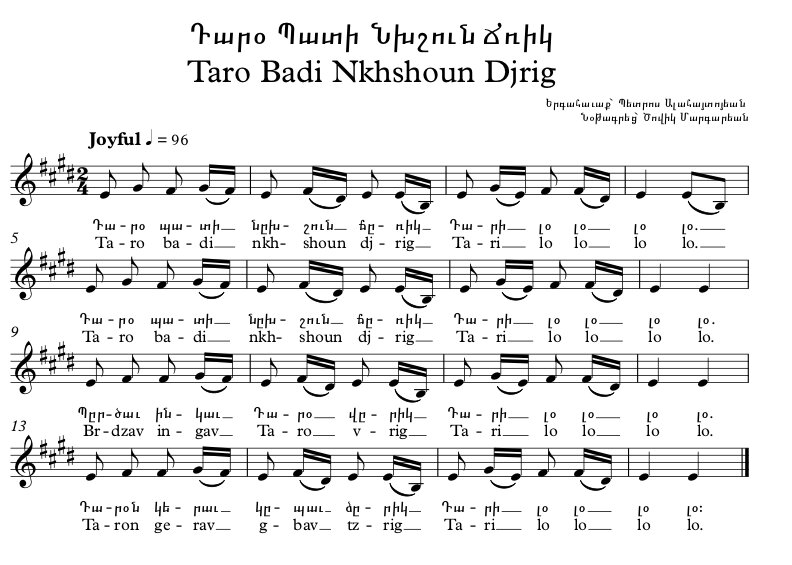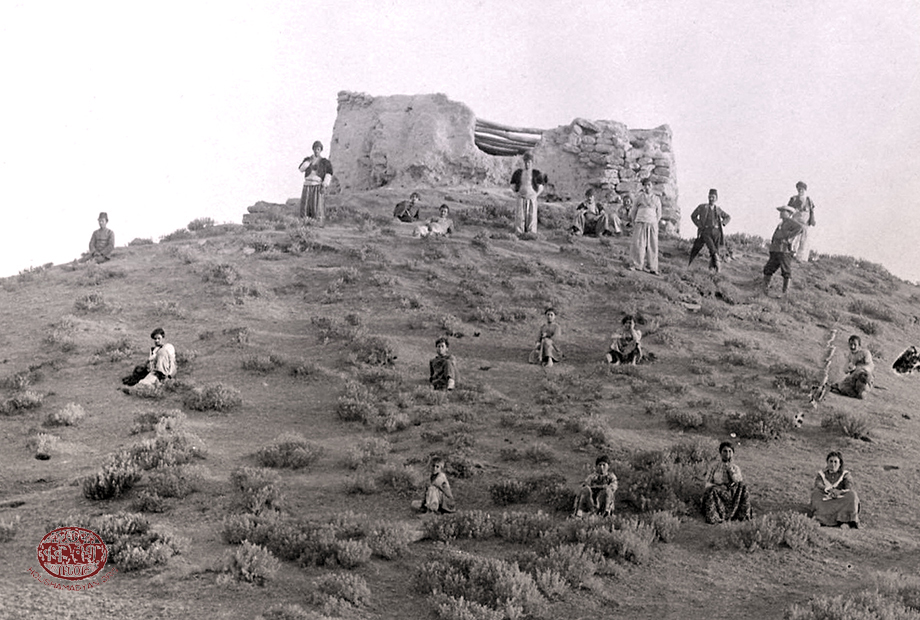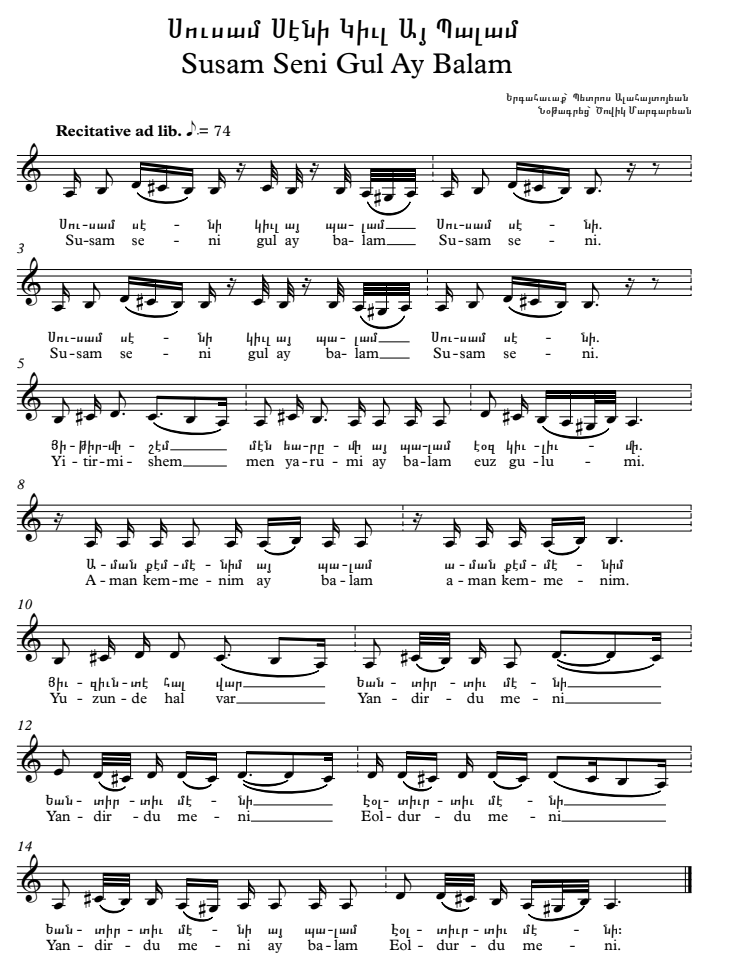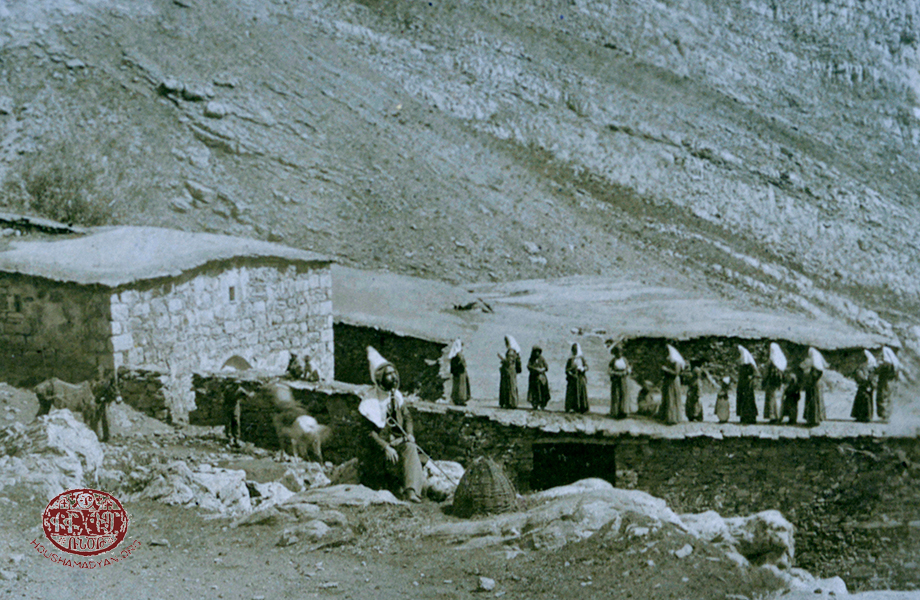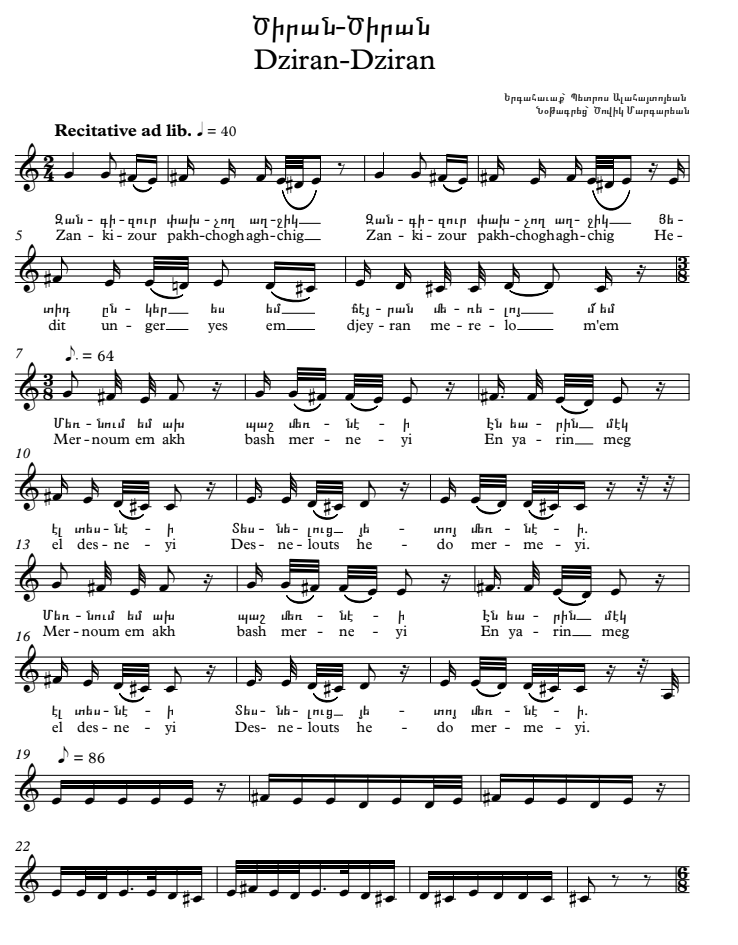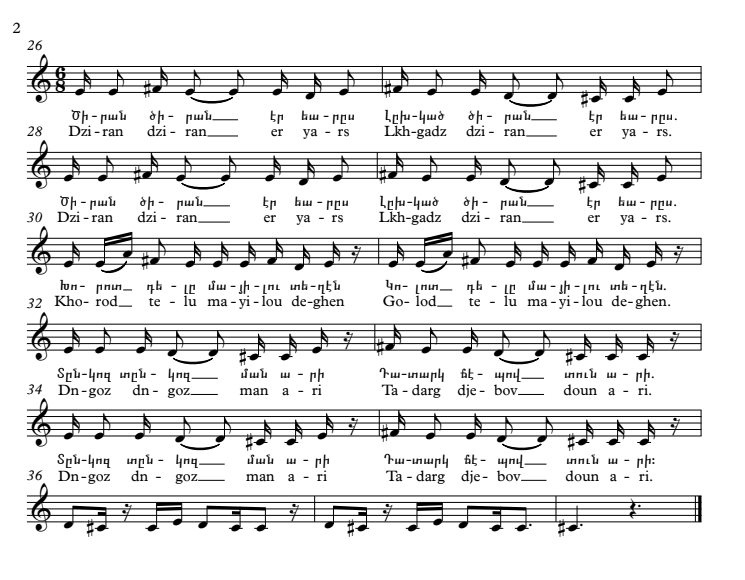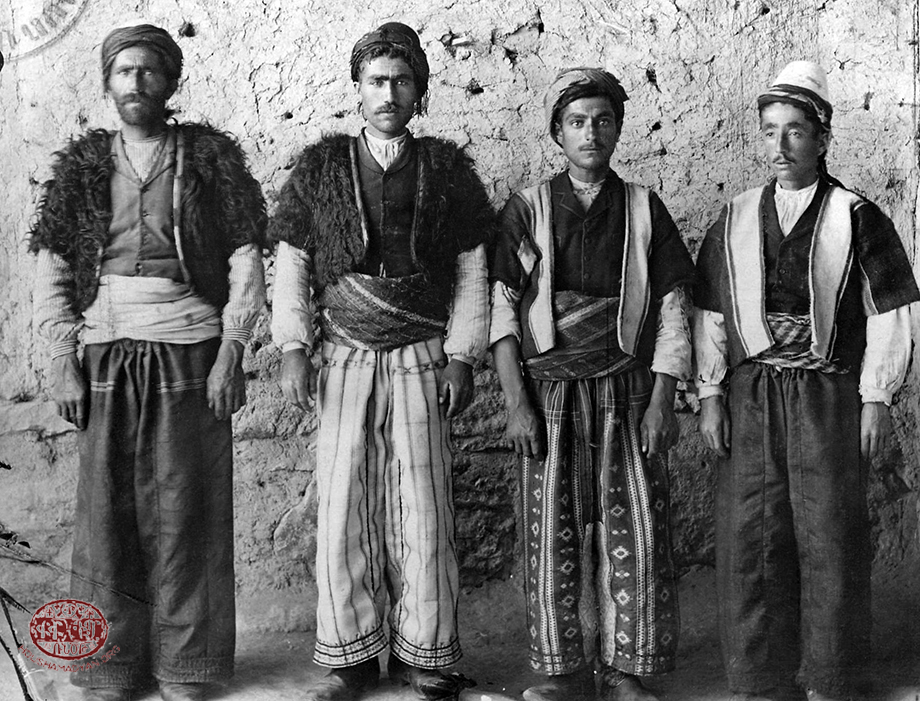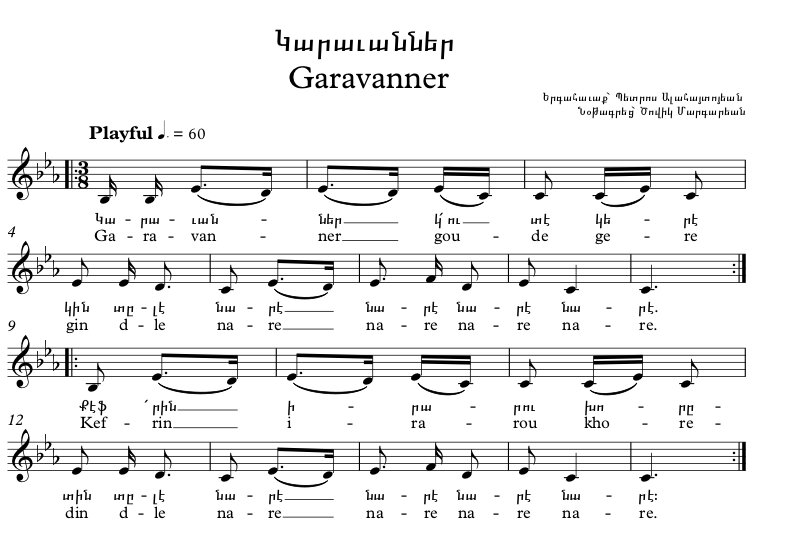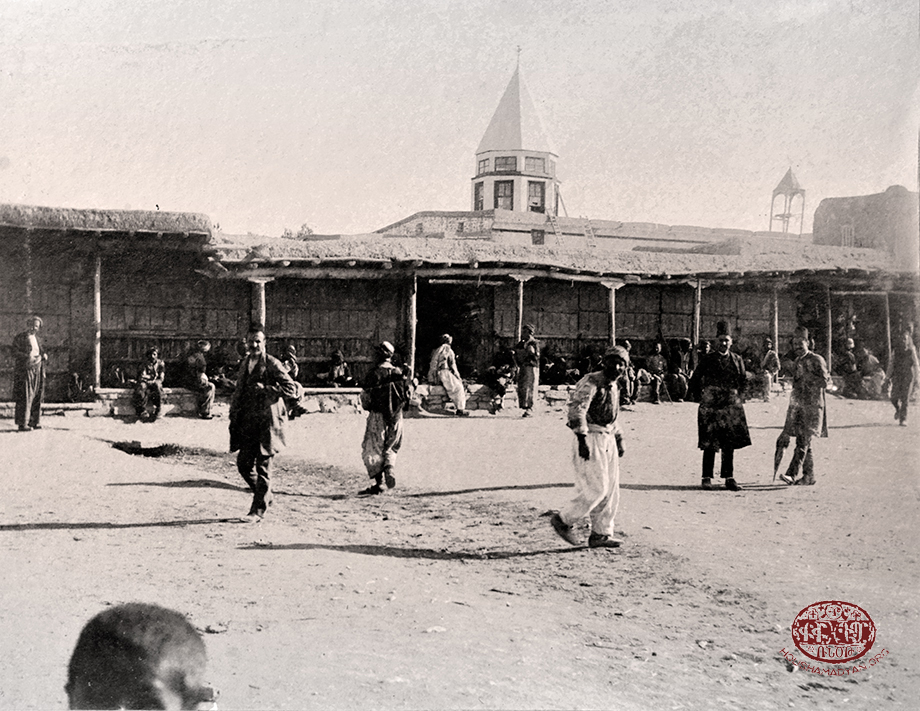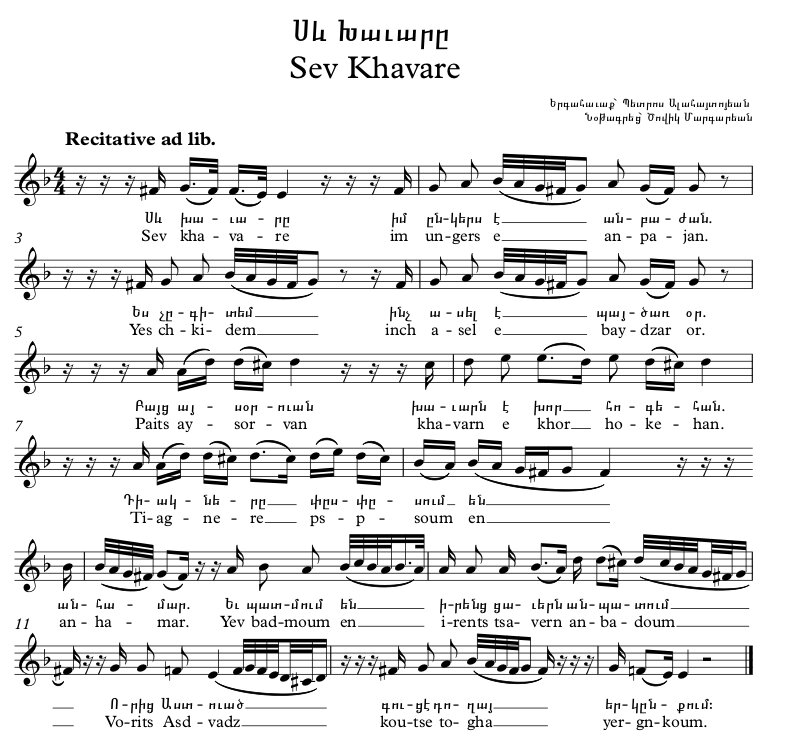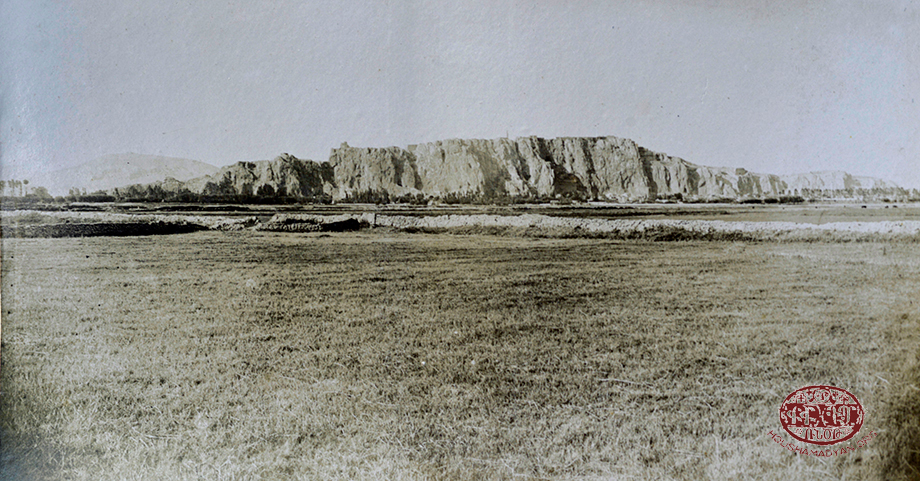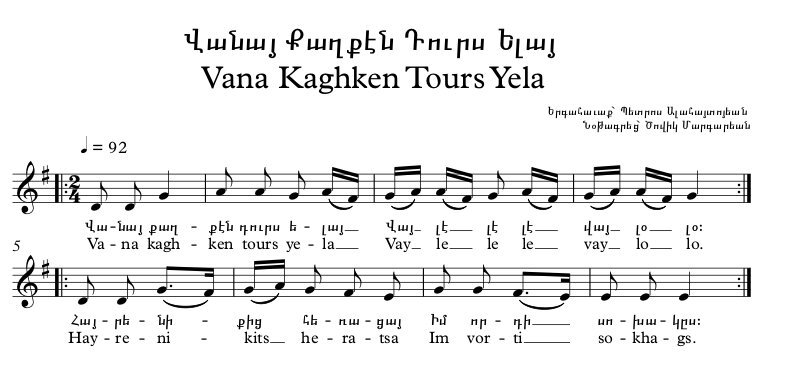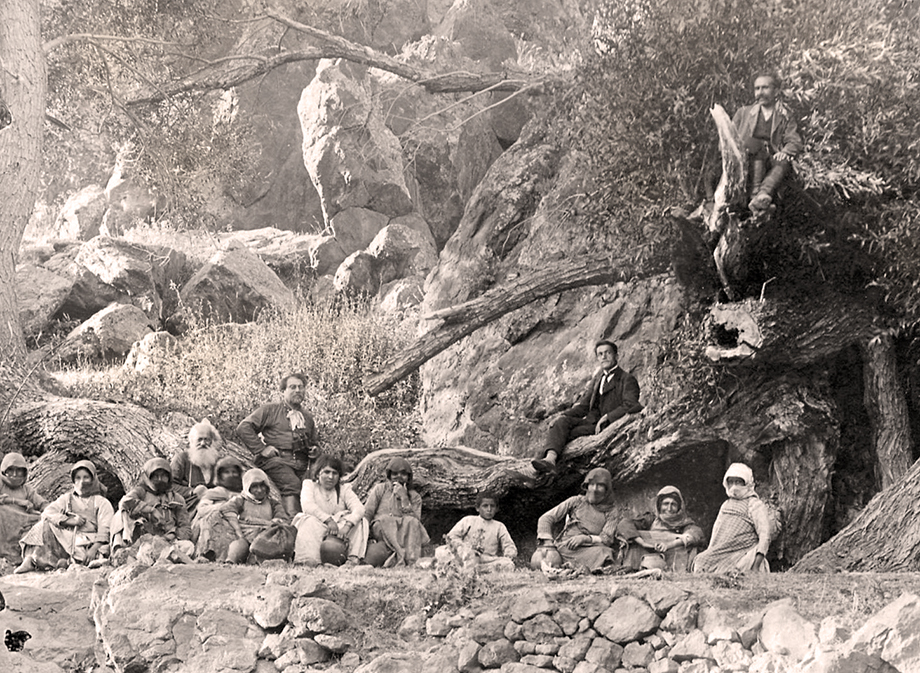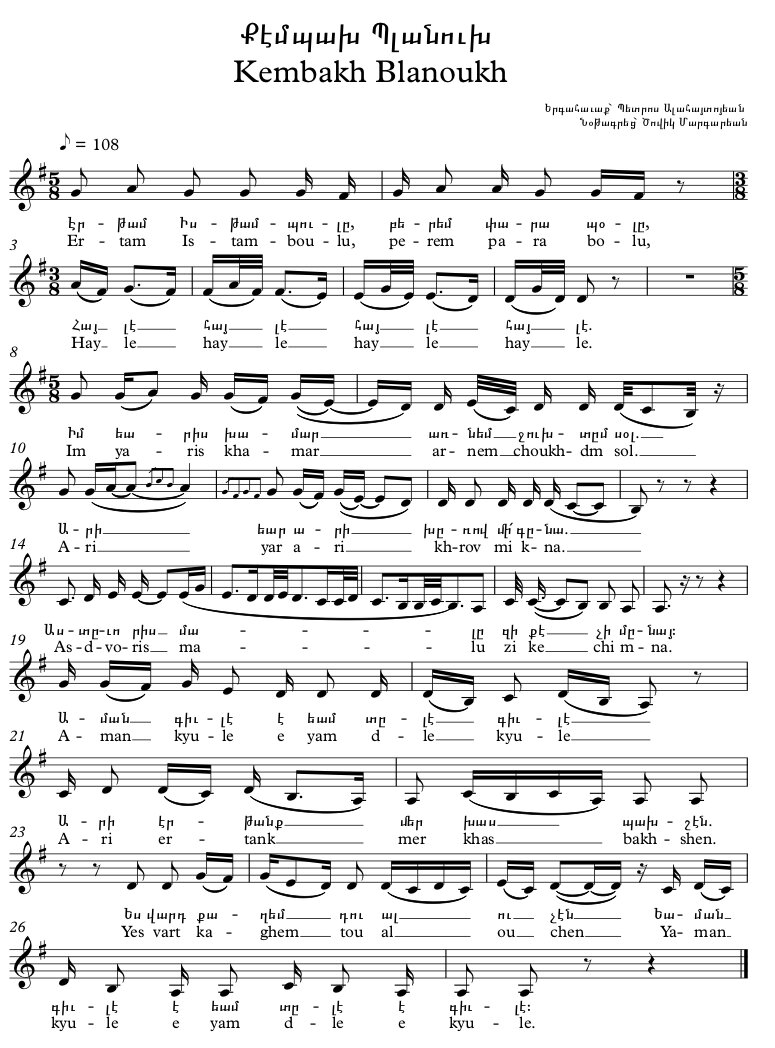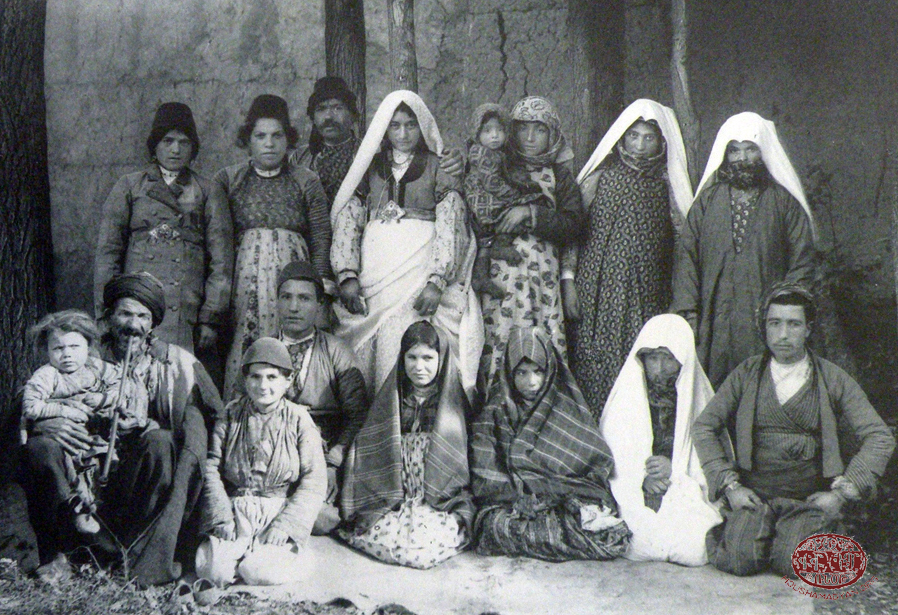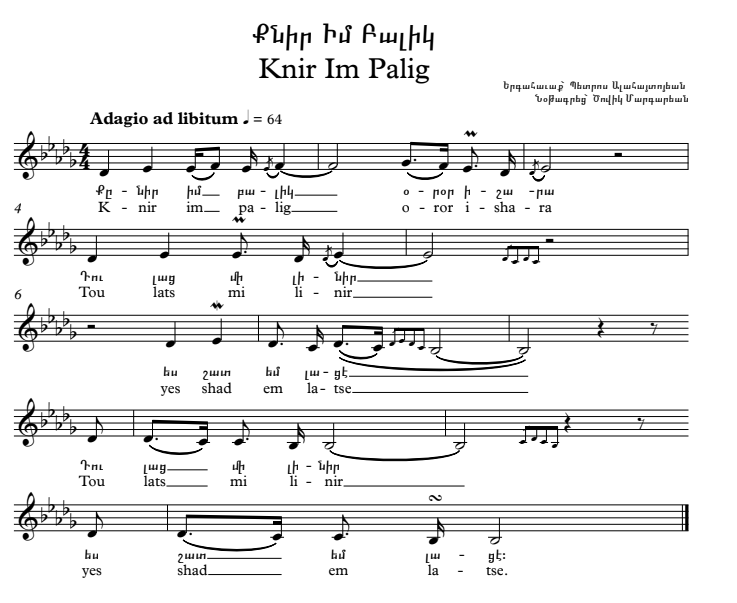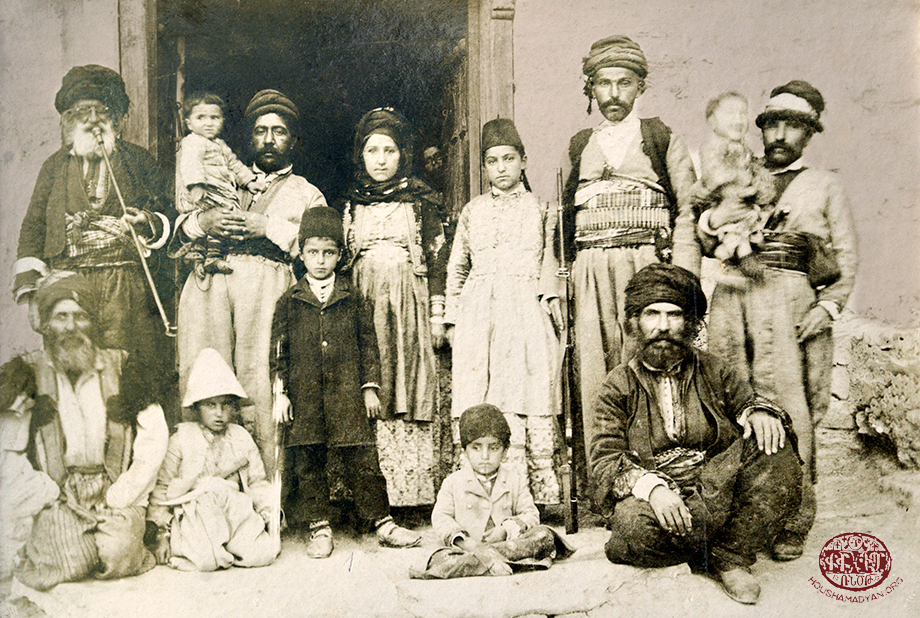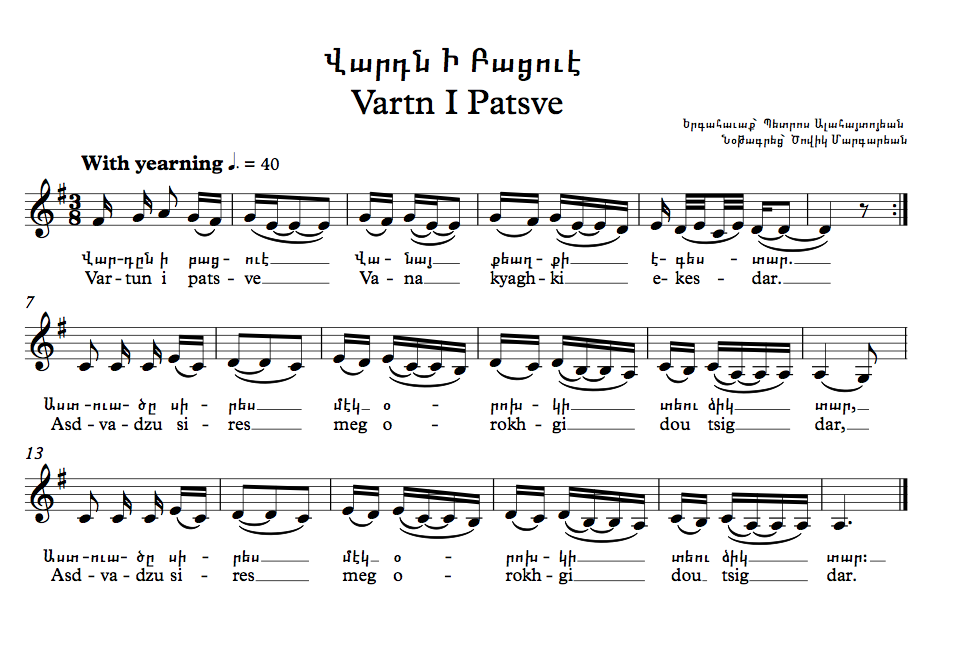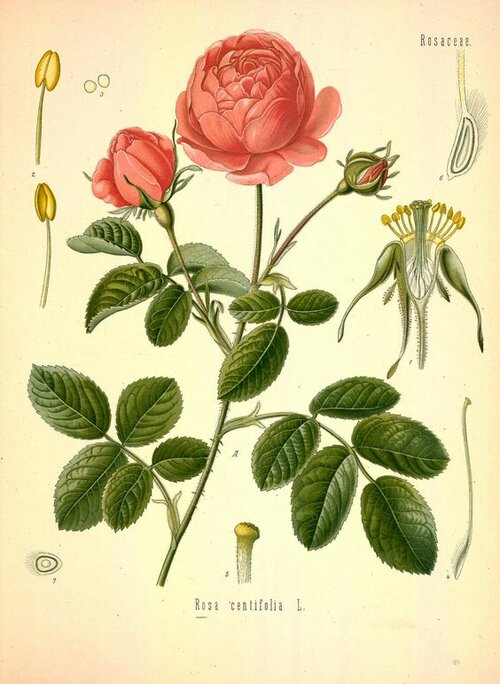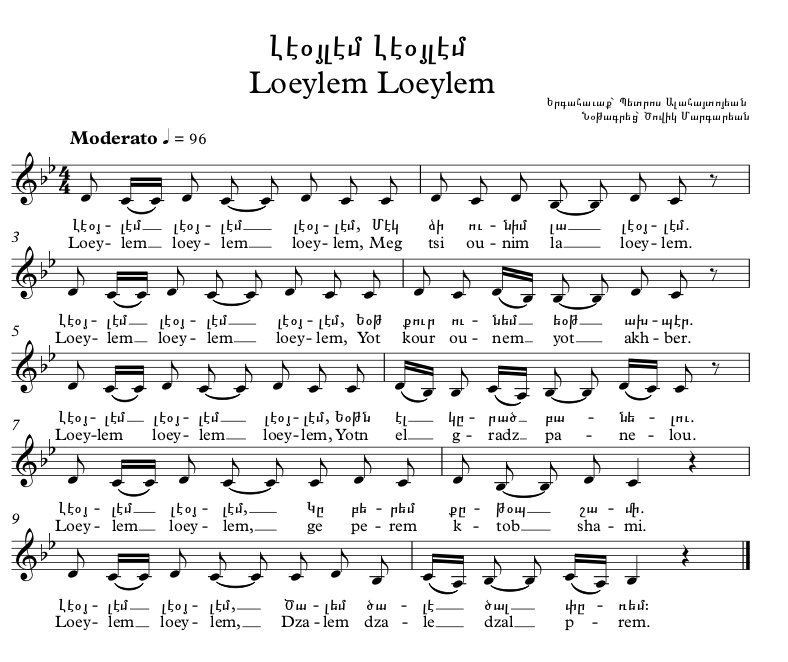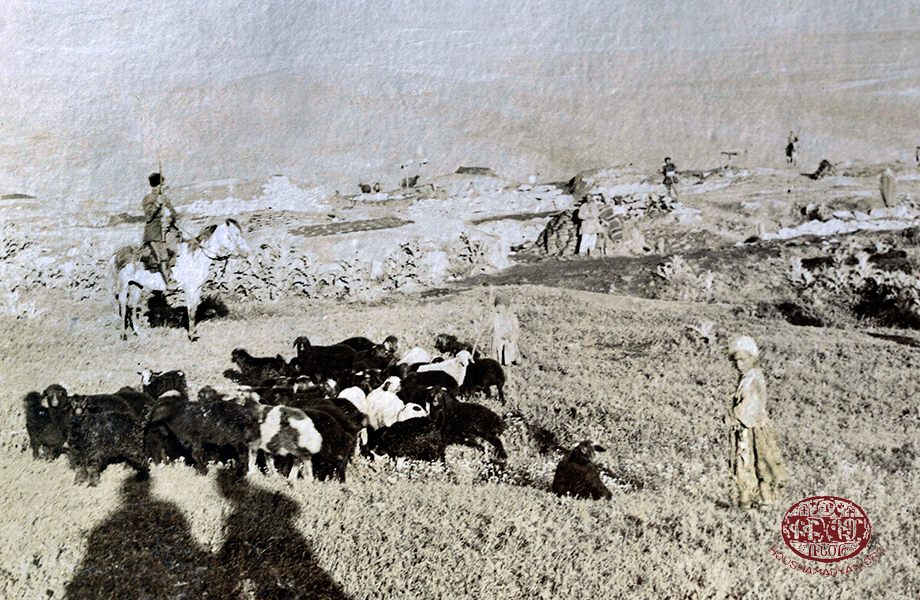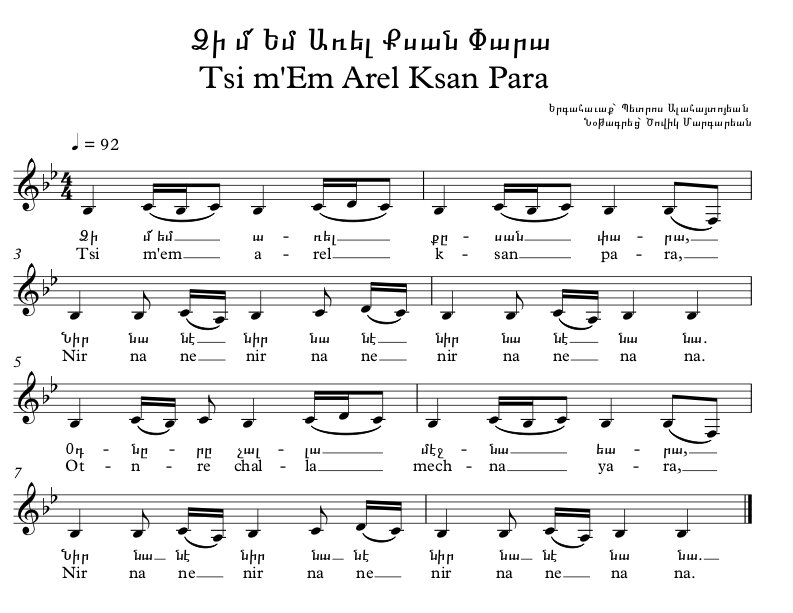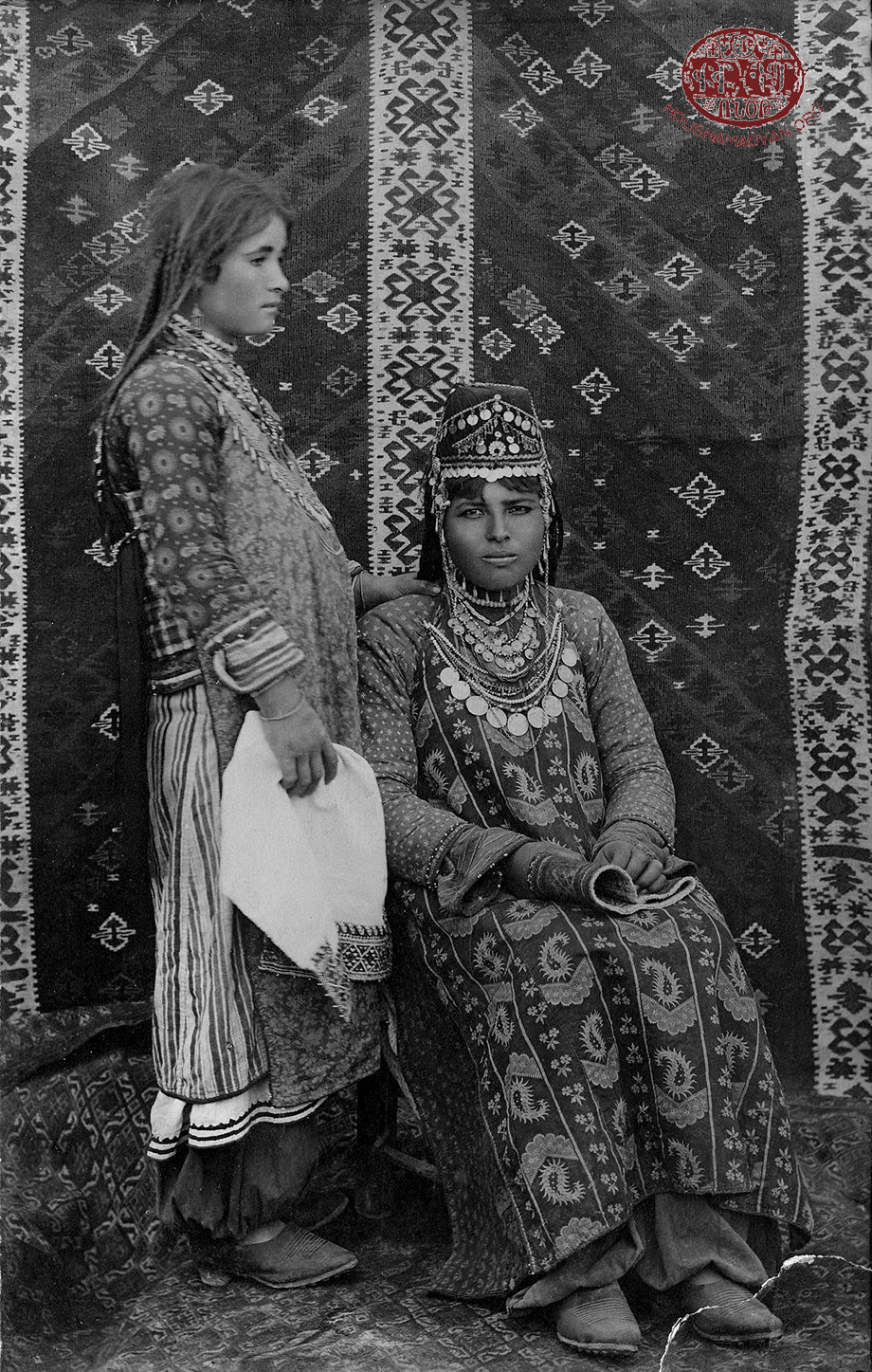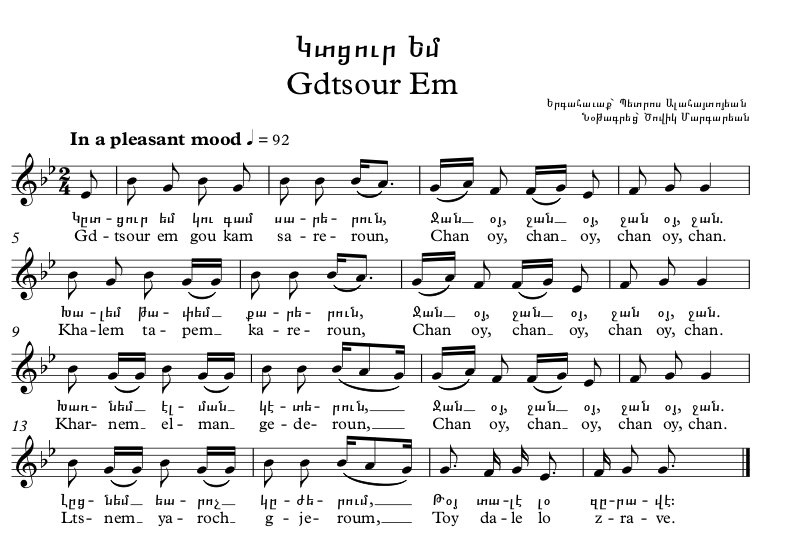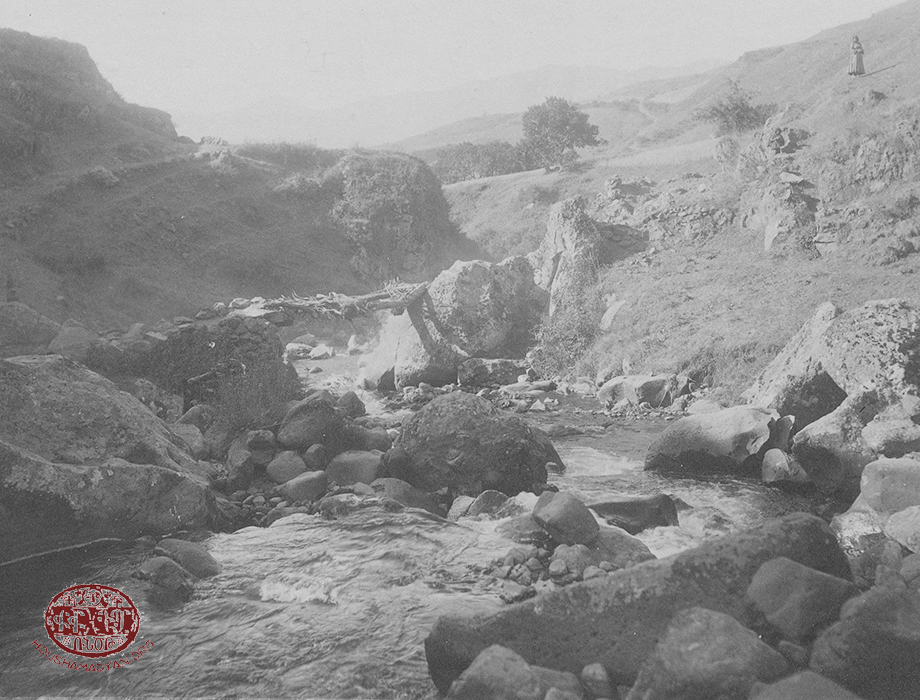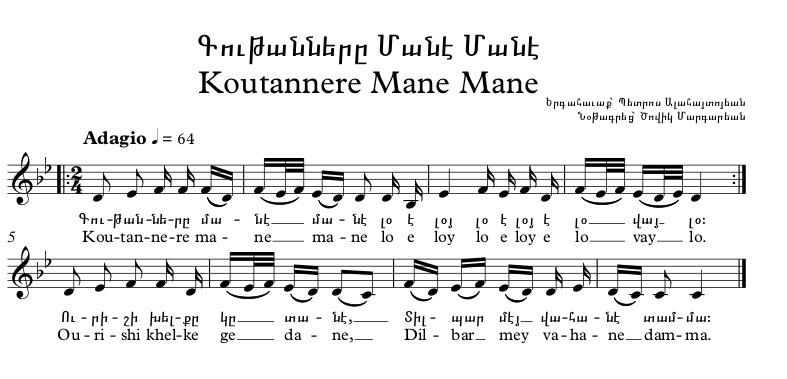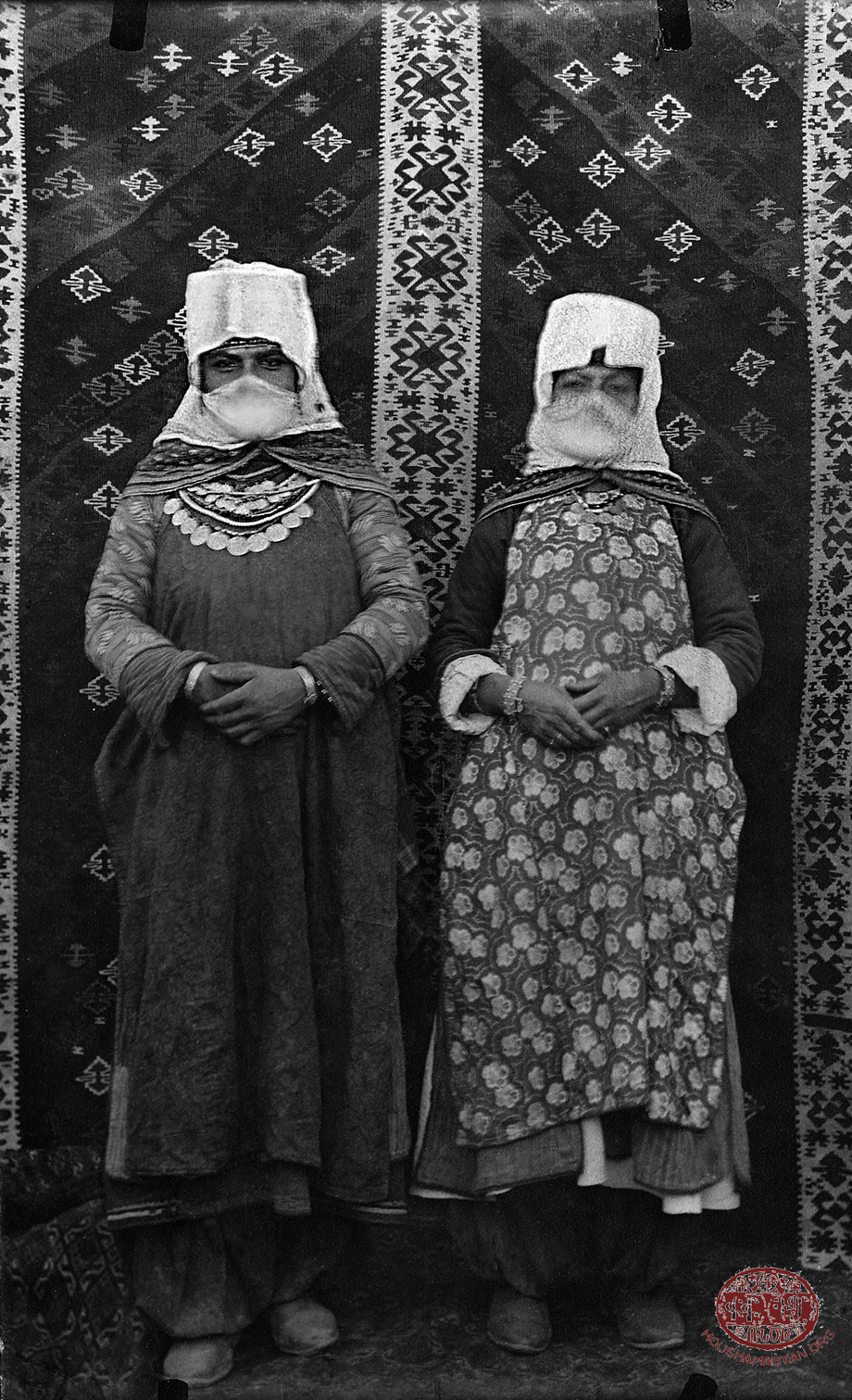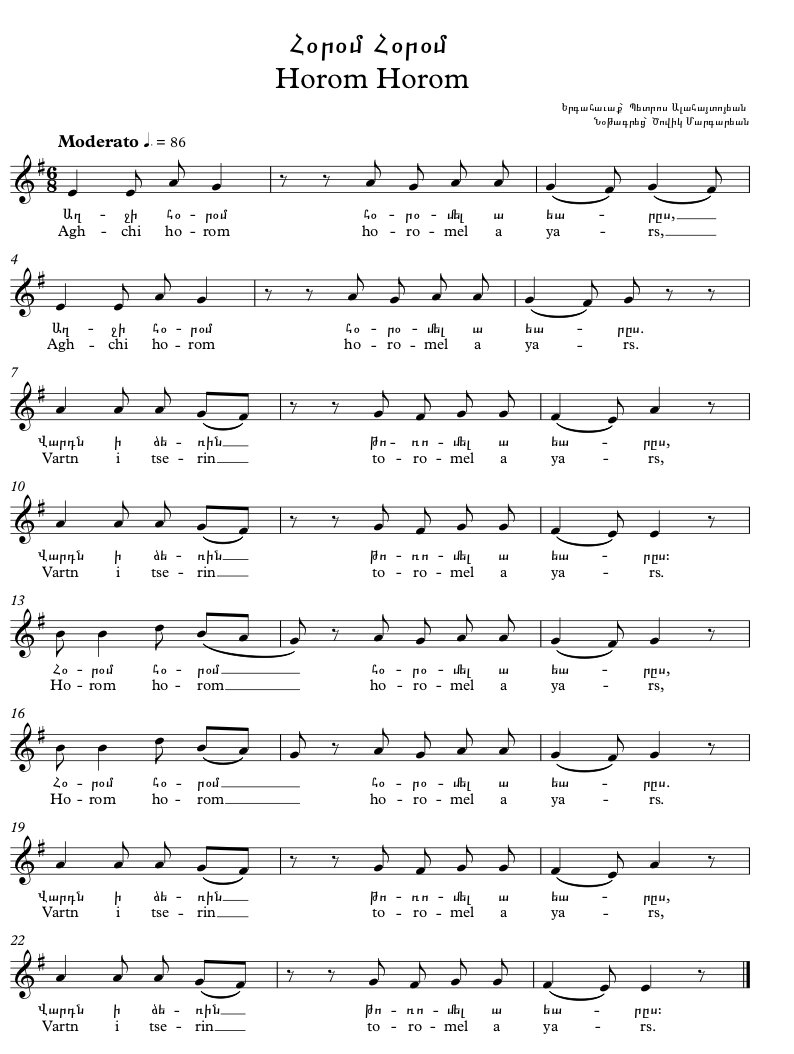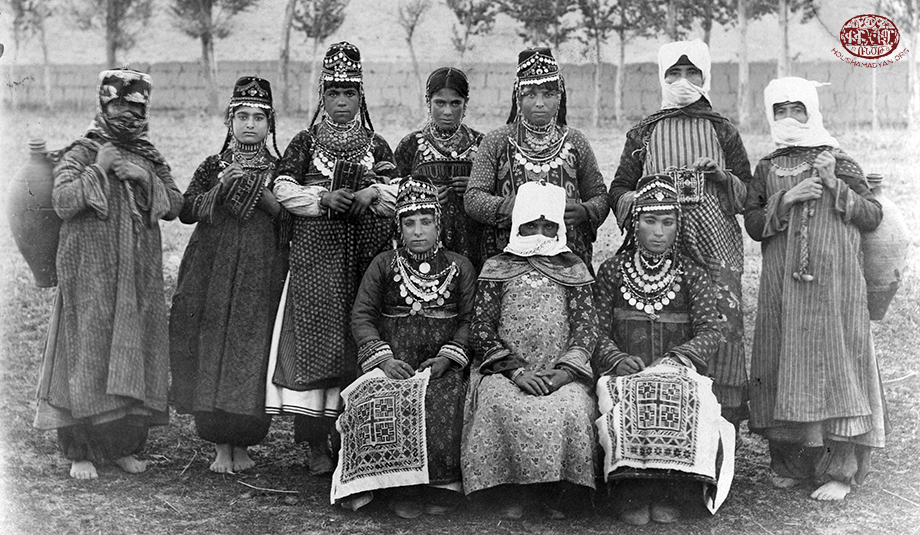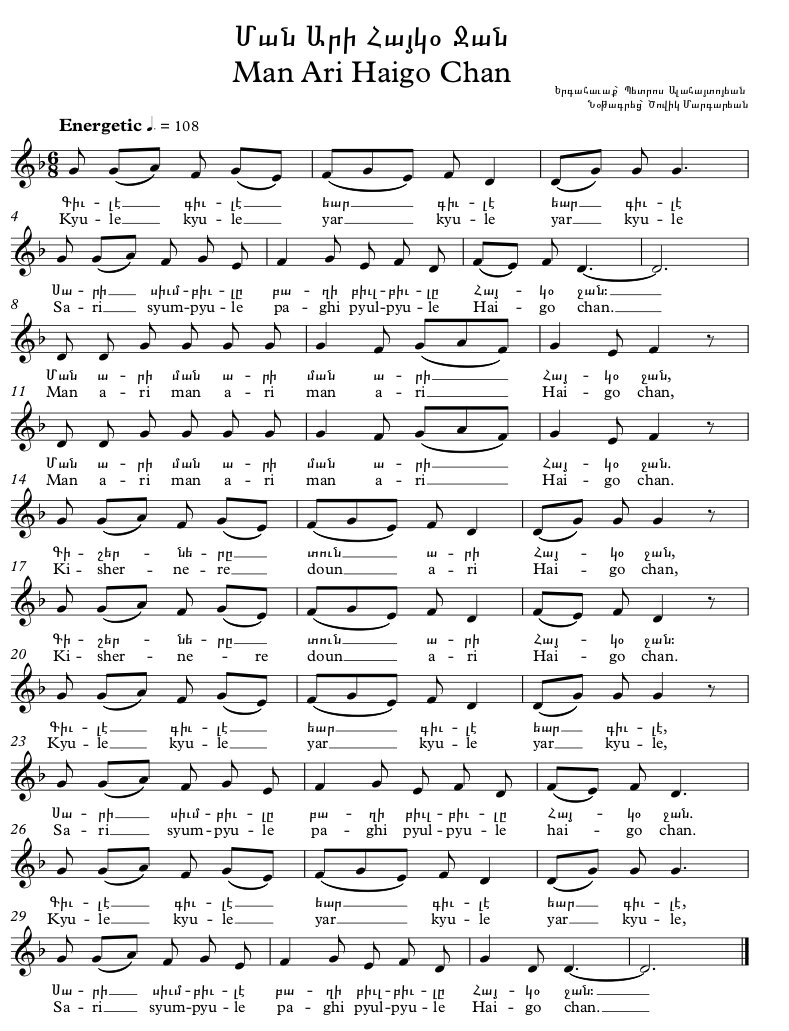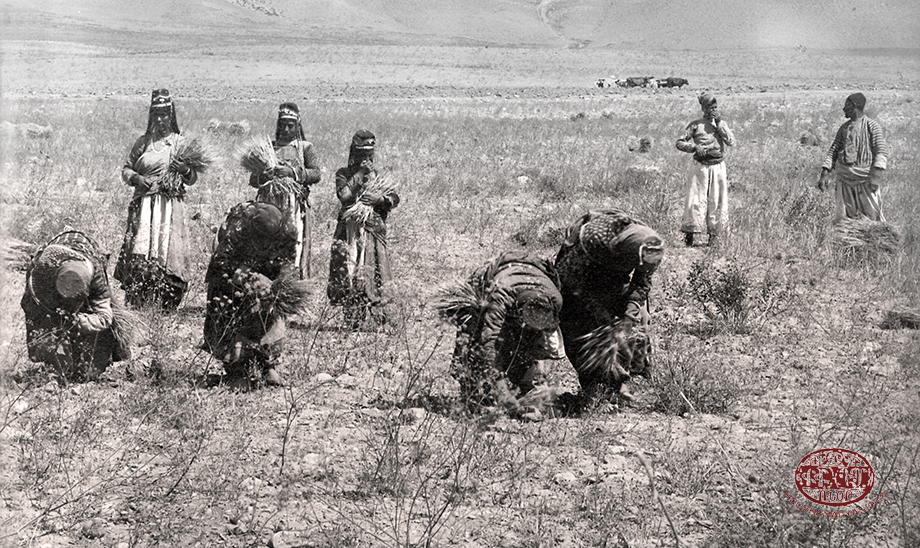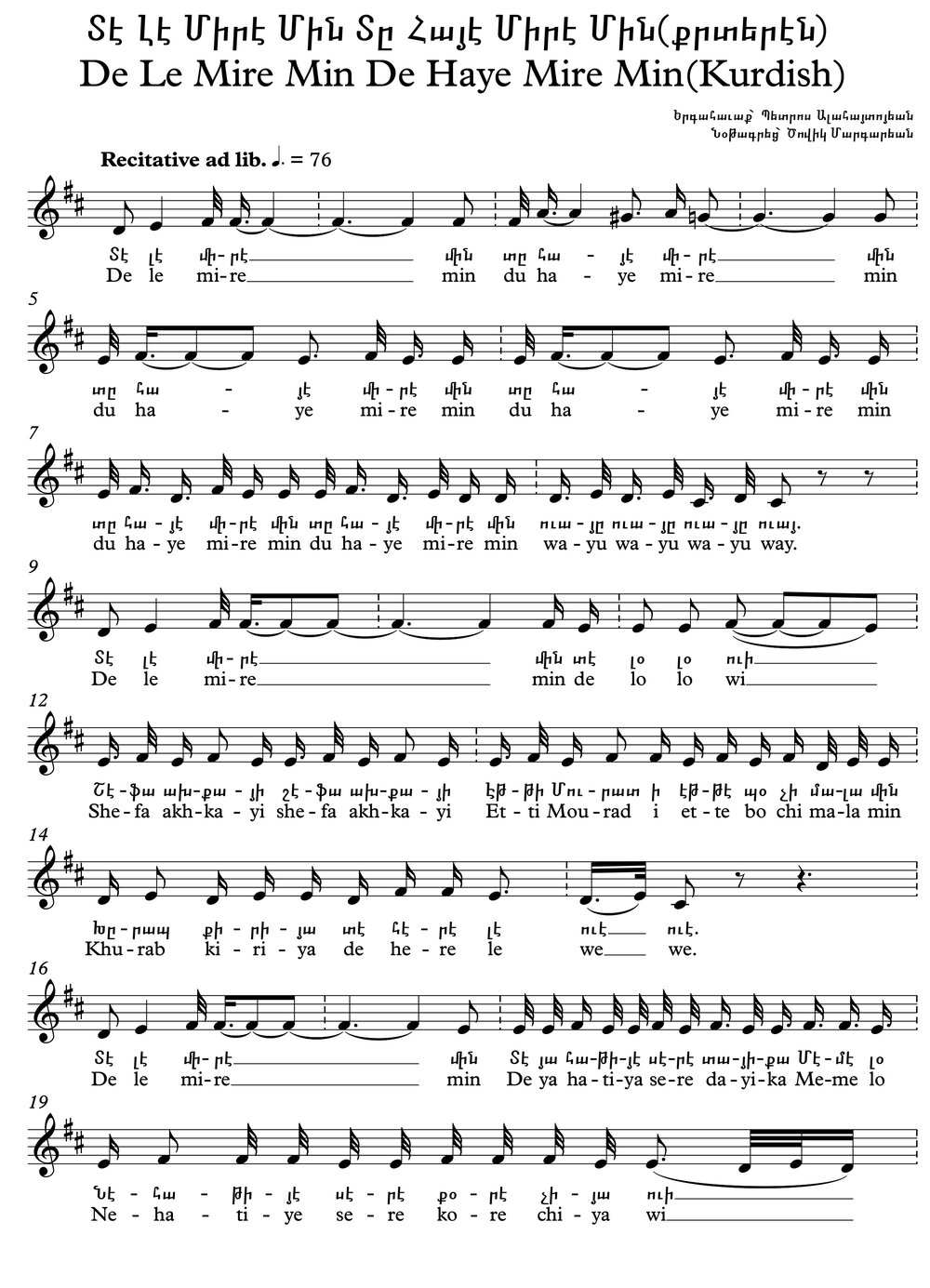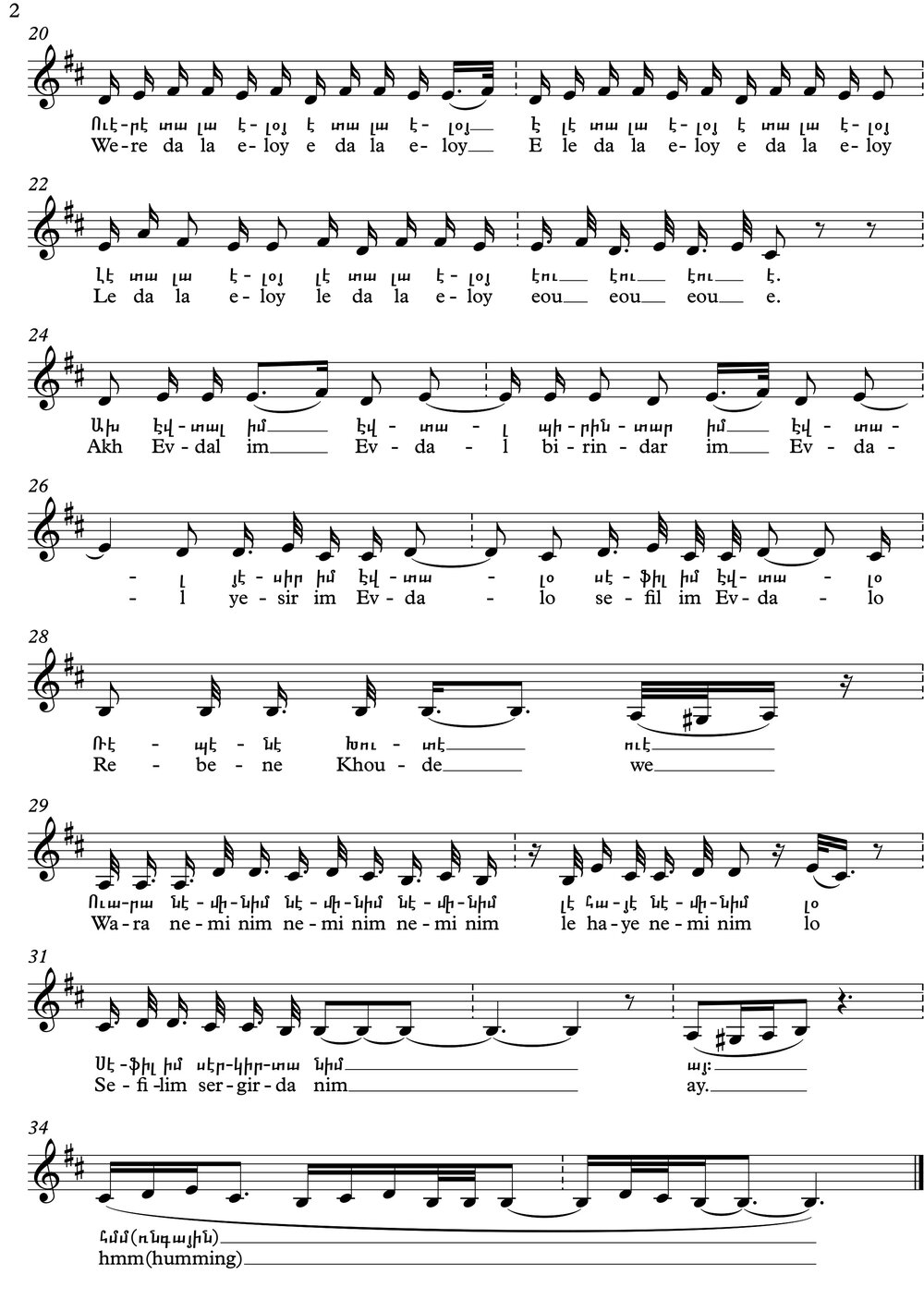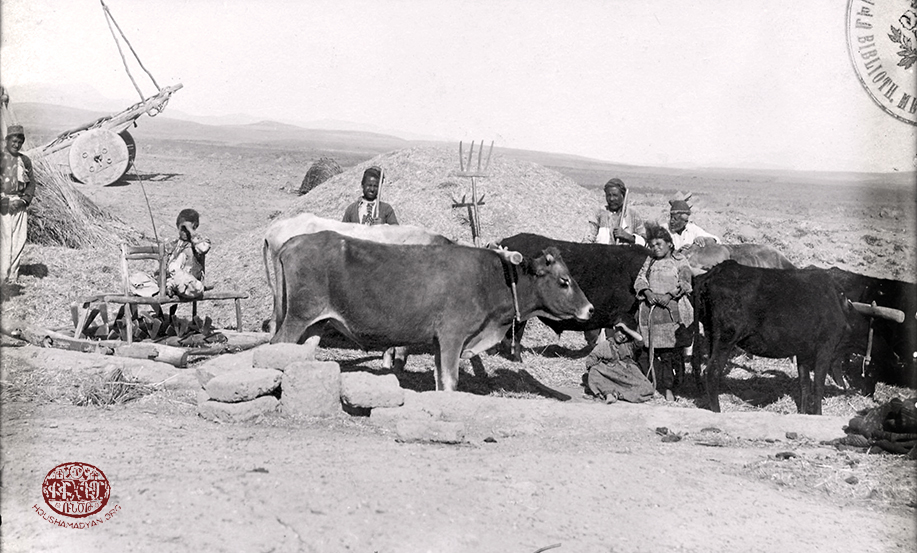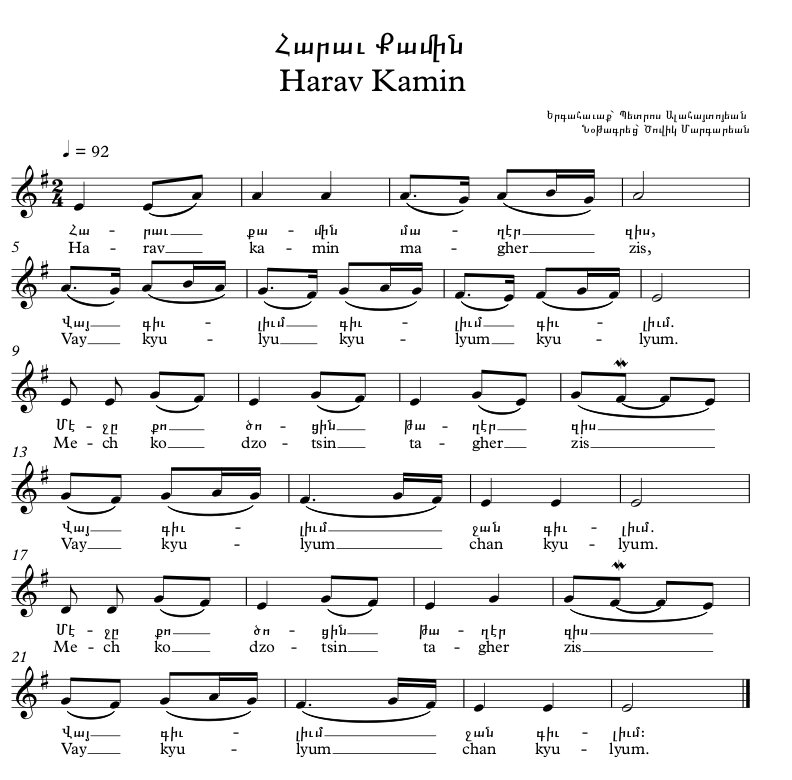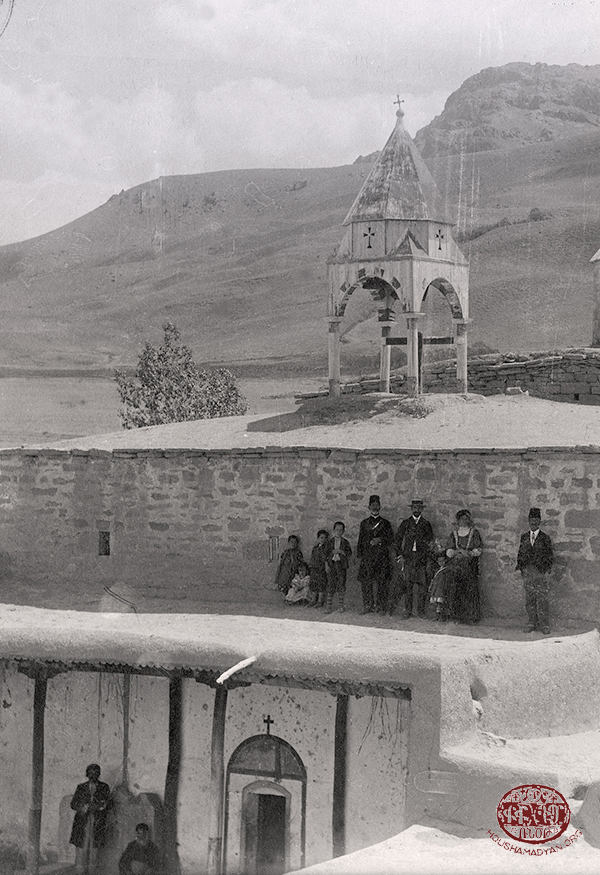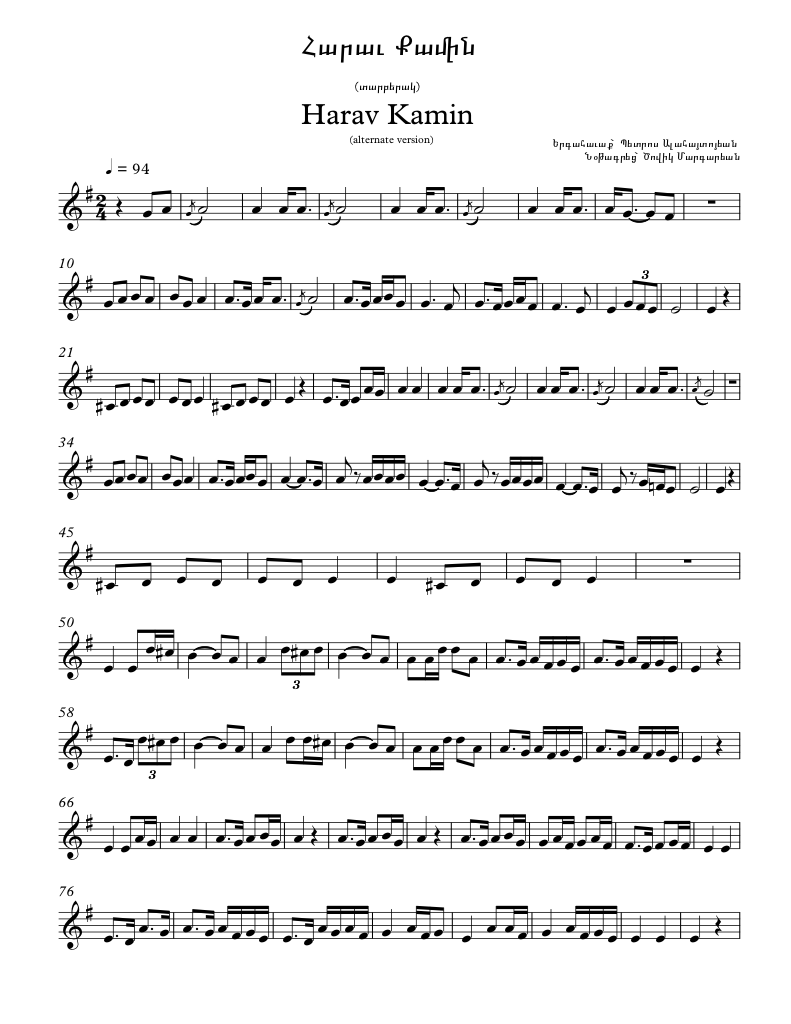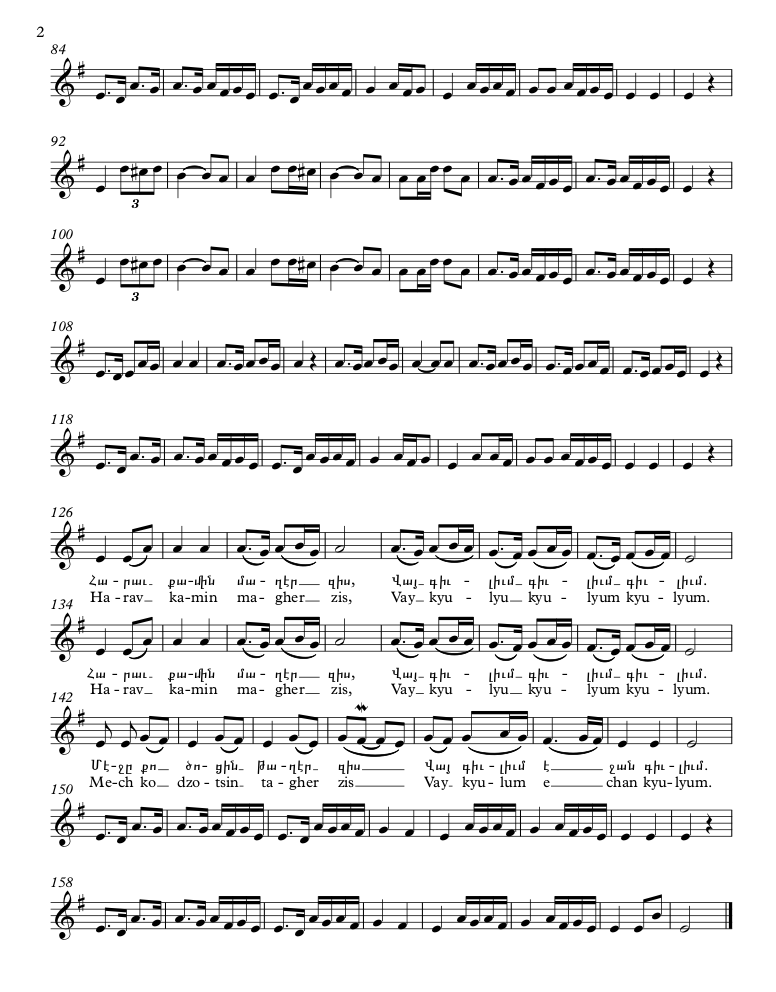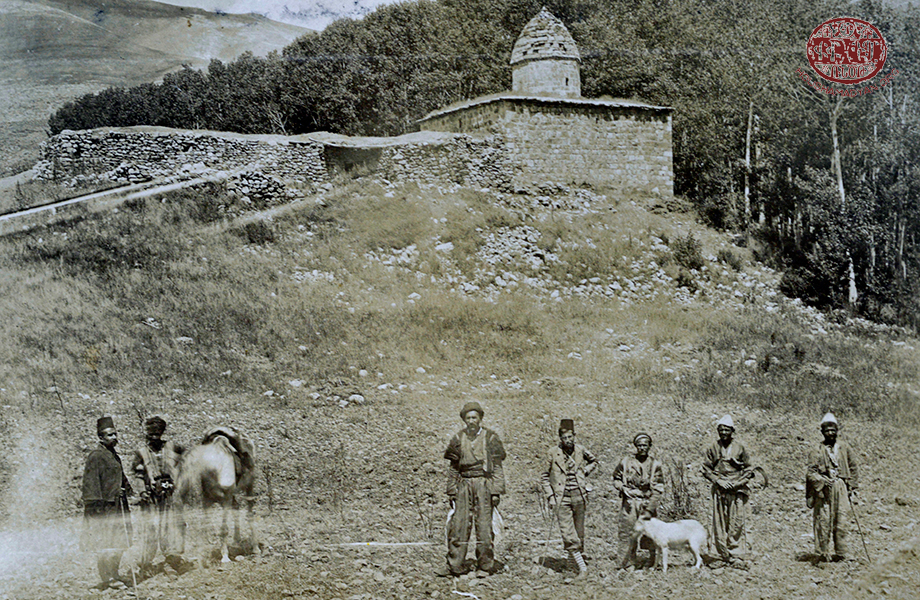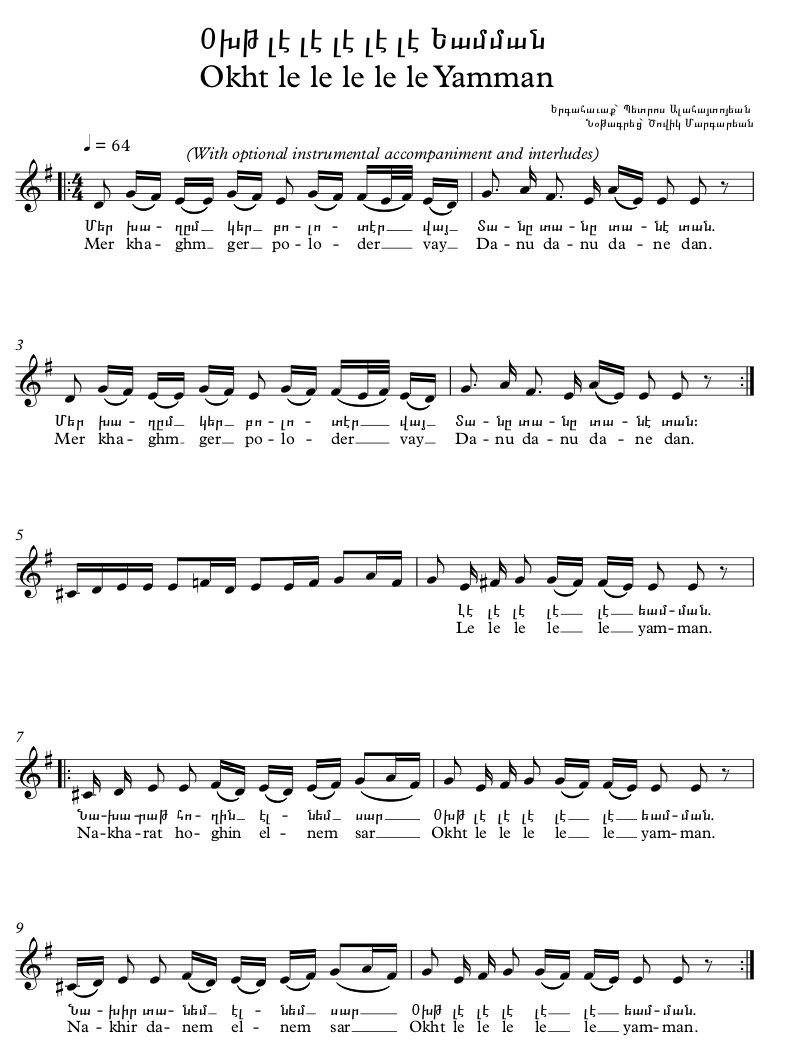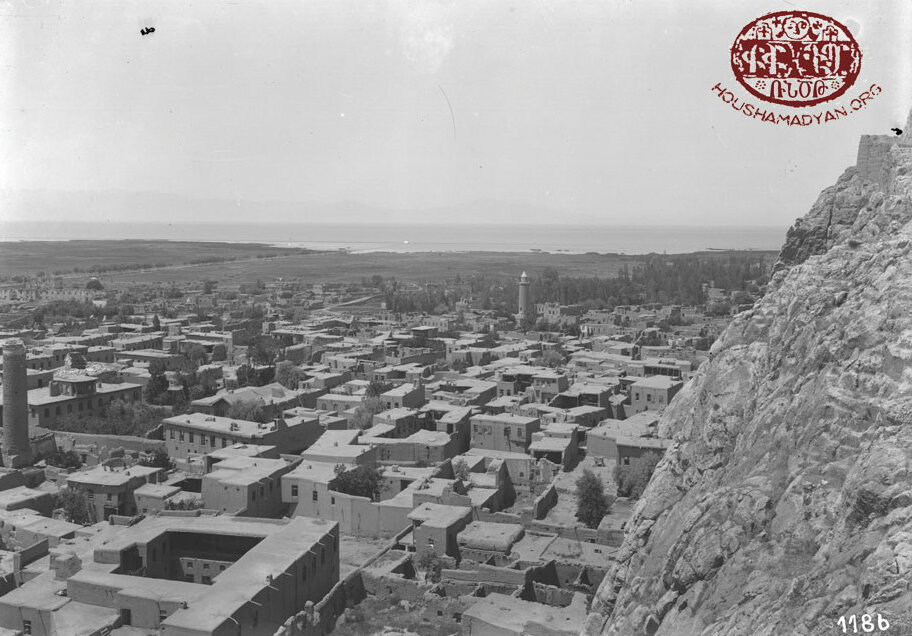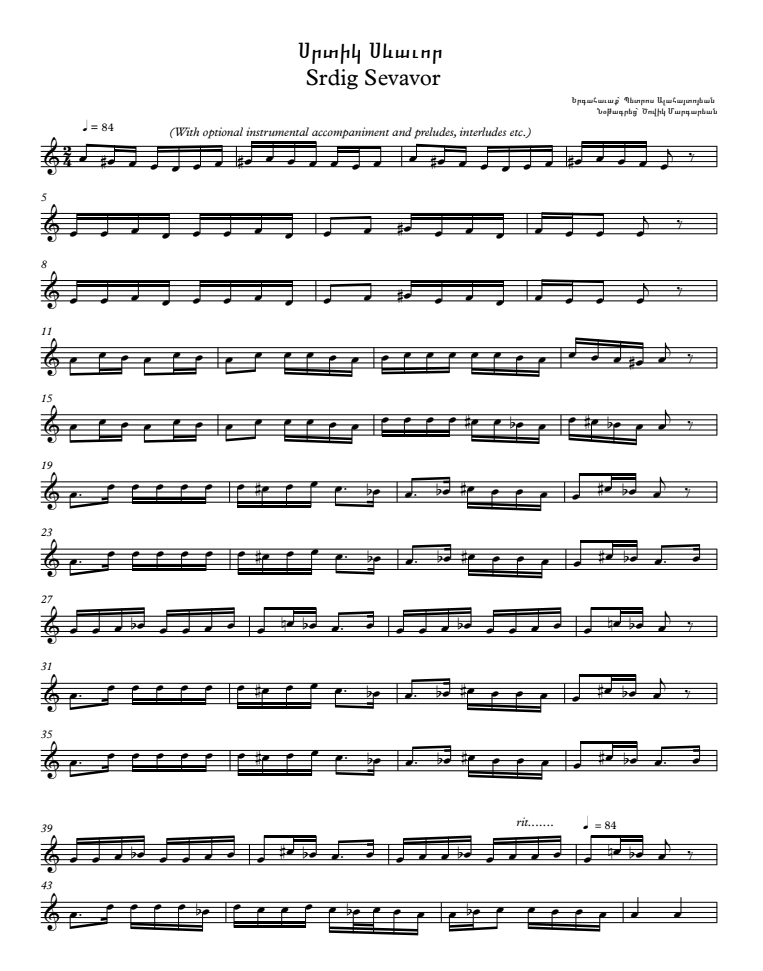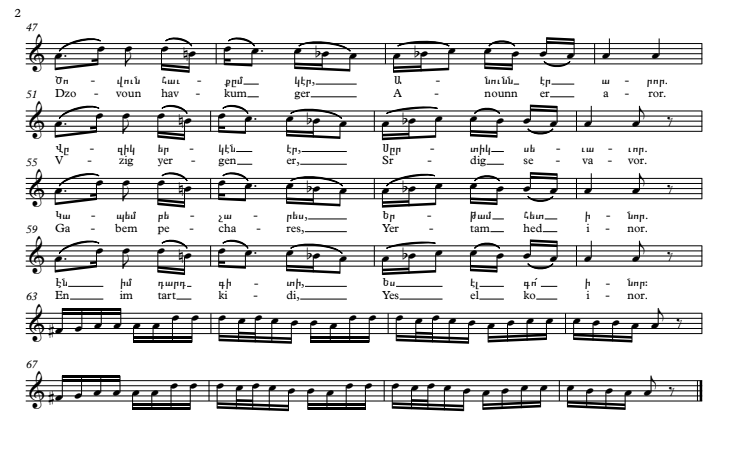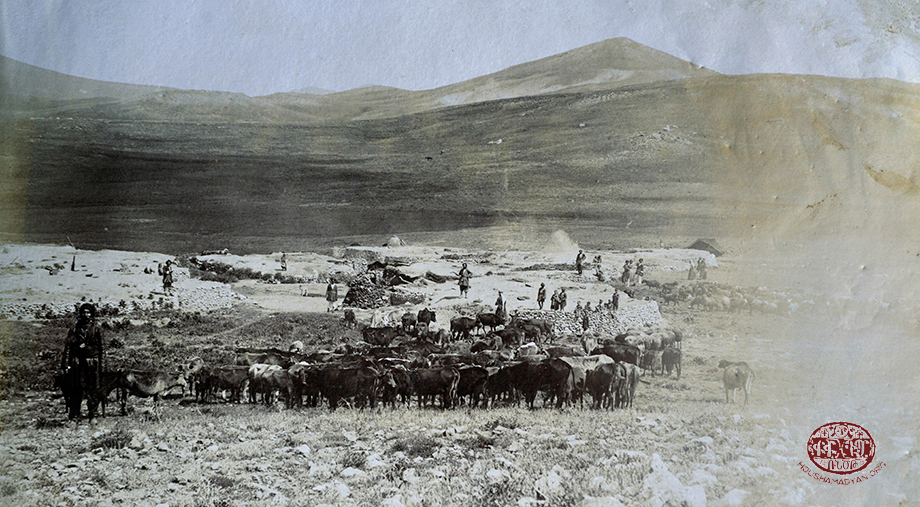Bedros Alahaidoyan Coll. 1 | Van
This page presents songs and dance music collected and recorded by musicologist Bedros Alahaidoyan. Beginning in the 1980s, Mr. Alahaidoyan traveled to cities and towns populated by Armenians throughout the Diaspora, in search for Genocide survivors from whom he collected rare songs and anecdotes of their native cities and villages.
Editing of this page, as well as music engraving and digitization, provided by Dzovig Markarian, DMA. Translation: Simon Beugekian.

Yenovk Der Hagopian
On November 25, 1986, Bedros Alahaydoian was in Boston, engaged in collecting material for his musical collection from the local community. There, he met Dr. Elizabeth Gregory, who was a descendant of Armenian Genocide survivors from Van, and had been a friend of Yenovk Der Hagopian’s, a minstrel and a native of Van.
Dr. Elizabeth Gregory put all musical recordings she had at the disposal of Mr. Alahaydoian. These included songs performed by Yenovk. Dr. Gregory also shared with Mr. Alahaydoian all information she had on Yenovk, and details of the friendship that she and he had shared.
During this meeting, Dr. Gregory herself performed songs from Van and provided an intimate account of how and whence she had learned these songs.
Yenovk Der Hagopian (1900-1966) was born in the village of Ishkhanikom in the area of Van (present-day Bakımlı, on the shores of Lake Van, south-west of the city of Van). He was a minstrel, musician, and sculptor. Yenovk’s grandfather had been a minstrel, and his father had been the priest of the Holy Cross Church on Akhtamar Island. During the Genocide, the family was rescued thanks to American missionaries and found refuge in Yerevan. In 1916, Yenovk received some education in art in Tbilisi, and in 1918-1923 he was employed as an administrator in the Yerevan and Nor Bayazid orphanages of the Near East Relief Foundation. In February 1921, he participated in the uprising against the communist regime in Armenia, and was wounded in the leg. The bullet that struck him was never removed from his body, and as a result, he suffered from a limp for the rest of his life.
In 1923 he emigrated to the United States, and settled on the east coast, in the state of Massachusetts. In 1948, he married Nvart Kalarchian.
According to Dr. Elizabeth Gregory, in the 1930s, when she was 13 years old, Yenovk and Elizabeth’s mother, Mayis Kachperouni, enjoyed a reputation as performers of traditional songs from Van. Every Saturday, the neighbors and the Armenian families in the area would gather in the house of Vahram and Koharig Santakordzian, in the city of Chelsea, to listen to these performances. A festive table would be laid out , stretching from the kitchen to past the threshold of the front door. Elizabeth’s mother would sit on one side of the table, and Yenovk on the other, and they would take turns singing until late into the night. It was a sort of musical duel to see which of them would run out of songs first.
According to Dr. Elizabeth Gregory, this friendship spanned many long years, and it was upon Yenovk’s advice that she, when young, alongside two sculptors, a Jewish painter, and musician-composer Alan Hovhannes, would meet on Saturday nights and go from house to house singings traditional songs from Van.
Some of Yenovk’s works of art are currently on display at the Armenian Library and Museum of America, in Watertown, Massachusetts. Among these works are oil paintings, as well as replicas of Armenian religious wood carvings.
Additional information on Yenovk Der Hagopian’s work and career can be found online at www.yenovkderhagopian.com
An animation film about the city of Van prepared by Houshamadyan. The citadel of Van appears in the opening scene, followed by the neighborhood of Aykesdan. In the distance is Varaka Mountain. Yenovk Der Hagopian, a Vanesti, performs the melodies that accompanies the film. He heard and learnt these tunes in his native Van.
Video concept, animation and edition: Olga Golikova and Silvina Der-Meguerditchian
1-Taro Badi Nkhshoun Djrig [A Lovely Cricket on Tario’s Wall]
2-Süsen-sümbül ay Balam
3-Dziran-Dziran [Apricot-Apricot]
4-Garavanner [Caravans]
5-Sev Khavare [Black Darkness]
6-Vana Kaghken Tours Yela [I Left the City of Van]
7-Kembakh Blanoukh
8-Knir Im Palig [Sleep, my Child]
9-Vart e mi Patsver [A Rose has Bloomed]
10-Loeylem Loeylem
11-Tsi M’em Arel Ksan Para [I’ve Bought a Horse for Twenty Paras]
12-Gdtsour em
13-Koutannere Mane Mane [The Plows Go Back and Forth]
14-Horom Horom
15-Man Ari Haigo Chan [Wandered Around, Dear Haigo]
16-De Le Mire Min De Haye Mire Min (Kurdish)
17-Harav Kamin [The South Wind]
18-Okht le le le le le
19-Srdig Sevavor [The Blackened Heart]

1- Taro Badi Nkhshoun Djrig
Taro badi nkhshoun djrig
Tari lo lo lo lo
Taro badi nkhshoun djrig
Tari lo lo lo lo
Brdzav ingav Taro vrig
Tari lo lo lo lo
Taron gerav gbav tsrig
Tari lo lo lo lo

2- Susam sen gül ay balam (Turkish song)
Süsen-sümbül ay Balam
Süsen seni
Süsen-sümbül ay Balam
Süsen seni
(Y)itirmişem men yâremi ay balam
Öz gülümi
Aman kemenim ay balam
Aman kemenim
(Y)üzünde hal var
Yandırdü meni
Yandırdü meni
Öldürdü meni
Yandırdü meni ay balam
Öldürdi meni
Sekiz (y)ıldir ay balam
Sekiz (y)ıldir
Sekiz (y)ıldir ay balam
Sekiz (y)ıldir
Görmemişem men yâremi ay balam
Öz gülümi
Aman kemenim ay balam
Aman kemenim
(Y)üzünde hal var
Yandırdü meni
Yandırdü meni
Öldürdü meni
Yandırdü meni ay balam
Öldürdü meni

3-Dziran dziran*
Zankizour pakhchogh aghchig
Zankizour pakhchogh aghchig
Hedit enger yes em djeyran merelo m’em
Mernoum em akh bash mernei
En yarin meg el desneyi
Desnelouts hedo merneyi
Hal-la ta-ram…
Dziran-dziran er yars
Lkhgatdz dziran er yars
Dziran-dziran er yars
Lkhgatdz dziran er yars
Khorod tele mayilou deghen
Golod tele mayilou deghen
Dngoz dngoz man ari
Tadarg djebov doun ari
Tay-ara em tari rayra ram
* A group of youth from Van once decided to earn a large amount of money by picking a large amount of apricots from Van’s orchards and selling them in Yerevan (residents of Yerevan could not grow their own apricots). But they did not take into consideration the fact that on the way to Yerevan, the heat would rot the apricots. They were unable to sell the fruit in the city, but being young, they took the incident in stride and wrote a song to commemorate their misadventure (this account of the song’s composition was related to Yenovk Der Hagopian by Dr. Gregory).

4-Garavanner
Garavanner goude gere gin
Dle nare nare nare nare
Ker urin irarou khorerin
Dle nare nare nare nare

5- Sev Khavare (written by Avedik Aharonian)
Sev khavare im engeres er anpajan
Yes chkidem inch asel e baydzar or
Payts aysorvan khavarn e khor hokegan
Tiagnere pspsoum en anhamar
Yev badmoum en irents tsavern anbadoum
Vorits Asdvadz koutse togha yergnkoum

6- Vana Kaghken Tours Yela
Dan-dan-da…
Vana kaghken tours yela
Vay le le le vay lo lo
Vana kaghken tours yela
Vay le le le vay lo lo
Hairenikits heratsa
Im vorti sokhags
Hayrenikits heratsa
Im vorti sokhags

7- Kembakh Blanoukh
Ertam Istanboule
Perem para bole
Hay le, hay le, hay le
Im yaris khamar arnem choukhdem sol
Ari, yar ari, khrov me kna!
Asdveris male zi ke chi mna
Aman gule e yam dele e gule
Ari ertank mer khas bakhchen
Yes vart kaghem tou al ou chen
Yaman gule e yam deme e gule
Kembakh Blanoukh, inch anoush kegh er
Yaris meg bake im srdin tegh er
Ari yar ari khrov mi kna!
Asdveris male zi ke chi mna
Aman gule e yam dele e gule
Ari ertank mer khas bakhchen
Yes vart kaghem tou al ou chen
Yaman gule e yam deme e gule
Ay!

8- Knir im Palig
Knir im palig orn ishara
Tou lats mi linir yes shad em latse
Tou lats mi linir yes shad em latse
Garavann antsav partsadz artsounkov
Mer sev yergnkov yegan ants gatsan (Sev anabadoum dzoung chokets mnats)
Akh mer lerneroum nrank gouratsan (Ayn mer ashkharhi dardn ou zouloumn e)
Tou lats mi linir yes shad em latse
Gouyr groungnere souk ou shivanov
Mer sev yergenkov yegan ants gatsan
Akh mer lerneroum nrank gouratsan
Tou lats mi linir yes shad em latse
The family of Mar Shimun, Patriarch of the Assyrian Church, circa, 1894.. The family lived in the south of Van Vilayet, in the Hakkari Sandjak, in the village of Kochanis.
Standing from left to right: Mar Yosip Sargis (Bishop of Jilu), Yonan Qambar (holding a baby, who is either Mar Poulos Mar Shimun or Zaia Mar Shimun - they were twins), Asiat Qambar, Surma Khanim Mar Shimun, Ishai Mar Shimun, unknown (holding second twin). And on the front row from left to right : Shlimun (the Patriarch’s jester/courtier), Hormizd Mar Shimun, Mar Benyamin Mar Shimun, Rob Khaila Dawid Mar Shimun, Mar Isaac Khnanisho. (Source: Bedros Yeghiayian collection, London. Courtesy of Jean-Pierre/Chabouh Kibarian).

9- Vartn i Patsve
Vartn i patsve Vana keaghkits ekesdar
Vartn i patsve Vana keaghkits ekesdar
Asdvadz sires meg orokhgi deou tzig dar
Asdvadz sires meg orokhgi deou tzig dar
Kea khorodig kea nazerov deou virn es
Kea khorodig kea nazerov deou virn es
Ashkharhe kidi alam kidi deou imn es
Ashkharhe kidi alam kidi deou imn es

10- Leoylem leoylem
Leoylem, leoylem, leoylem,
Meg tsi ounim la leoylem
Leoylem, leoylem, leoylem,
Yot kour ounem yot akhber
Leoylem, leoylem, leoylem,
Yotn el gtsadz panelou
Leoylem, leoylem,
Ge perem kbod shami
Leoylem, leoylem,
Dzalem dzale dzel prem

11- Tsi M’em Arel Ksan Para
Tsi m’em arel ksan para
Nir na ne, ne na ne, nir na ne, na na
Otnere challa mechna yara
Nir na ne, ne na ne, nir na ne, na na
Keoreon yegav yana yana
Nir na ne, ne na ne, nir na ne, na na
Terperod er medkes pana
Nir na ne, ne na ne, nir na ne, na na

12- Gdtsour Yem
Gdtsour em gou kam sareroun
Chan oy, chan oy, chan oy, chan
Khalem tapem kareroun
Chan oy, chan oy, chan oy, chan
Kharnem elman gederoun
Chan oy, chan oy, chan oy, chan
Letsnem yaroch gejeroum
Toy dalelo kerave

13- Koutannere Mane Mane
Koutannere mane mane
Lo e loy lo e loy lo vay lo
Koutannere mane mane
Lo e loy lo e loy lo vay lo
Ourishi khelke gdane
Dilbar mey vahane damma
Sheg aghchig hats ge dane
Lo e loy lo e loy lo vay lo
Sheg aghchig hats ge dane
Dilbar mey vahane damma

14- Horom Horom
Aghchi horom horomel a yars
Aghchi horom horomel a yars
Vartn i tserin toromel a yars
Vartn i tserin toromel a yars
Horom horom, horomel a yares
Horom horom, horomel a yares
Vartn i tserin toromel a yars
Vartn i tserin toromel a yars
Aghchi horom kroghe kez togh dani
Aghchi horom kroghe kez togh dani
Arjan chellar me ktotse tarmani
Arjan chellar me ktotse tarmani
Horom horom, horomel a yares
Horom horom, horomel a yares
Vartn i tserin toromel a yars
Vartn i tserin toromel a yars
Ba chek asoum horomin darel en
Ba chek asoum horomin darel en
Okhte nor e saroume bahel en
Okhte nor e saroume bahel en
Horom horom, horomel a yares
Horom horom, horomel a yares
Vartn i tserin toromel a yars
Vartn i tserin toromel a yars
Tan-tara…

15- Man Ari, Haygo Chan
Ta-ra-ri…
Kule kule yar kule yar kule
Sari sumpule paghi pulpule Haigo chan
Kule kule yar kule yar kule
Sari sumpule paghi pulpule Haygo chan
Man ari, man ari, man ari, Haygo chan
Man ari, man ari, man ari, Haygo chan
Kishernere doun ari, Haygo chan
Kishernere doun ari, Haygo chan
Kule kule yar kule yar kule
Sari sumpule paghi pulpule, Haygo chan
Kule kule yar kule yar kule
Sari sumpule paghi pulpule, Haygo chan

16- De Le Mire Min De Haye Mire Min (Kurdish)
The Kurdish transcription of the song was done by Sedat Ulugana (a Ph.D. candidate in France).
de lê mîrê min de hayê mîrê min de hayê mîrê min wayê
de lê mîrê min de lo lo wî şefa axkayî şefa axkayî tu Mûrad î
te bo çi mala min xerab kiriye de herê lê wê wê
de lê mîrê min de ya hatiye serê dayika Memê lo
nehatîye serê gurê çîya wîî, were de loy lo de loy lo lê de loy lo
ax Evdal im Evdal, birindar im Evdal, (y)êsîr im Evdalo, sefîl im Evdalo, Rebenê Xwedê wêê
were nemînim nemînim nemînim lê hayê nemînim lo sefîl im sergirda nim

17- Harav Kamin
Harav kamin magher zis
Vay kulum kulum kulum
Mech ko dzotsin tagher zis
Vay kulum e, chan kulum
Mech ko dzotsin tagher zis
Vay kulum kulum kulum
Sasna g’eller parag moukh
Vay kulum kulum kulum
Yarig m’ounem Blanoukh
Vay kulum e, chan kulum
Yarig m’ounem Blanoukh
Vay kulum e, chan kulum
Harav kamin magher zis
Vay kulum kulum kulum
Mech ko dzotsin tagher zis
Vay kulum e, chan kulum
Mech ko dzotsin tagher zis
Vay kulum e, chan kulum

Harav kamin (alternate version)
Harav kamin magher zis
Vai kyulyum kyulyum
Mech ko dzotsin tagher zis
Vai kyulyum kyulyum
Mech ko dzotsin tagher zis
Vai kyulyum kyulyum

18- Okht Le Le Le Le Le Yamman
Mer khaghum ger poloder vay
Dane dane daneh dan
Mer khaghem ger poloder vay
Dane dane daneh dan
Touk tser poghotse man gou ker vay
Dane dane daneh dan
Inch gndener goul gou der vay
Dane dane daneh dan
Mer khaghem ger more m’eger
Dane dane dane dan
Chider midev dasnemeg er
Dane dane dane dan
(Le le le le le yaman)
Nakharat hoghin elnem sar
Okht le le le le le yaman
Nakhir danem elnem sar
Okht le le le le le yaman
Khntsor talem arev dar
Okht le le le le le yaman
Khntsor talem arev dar
Okht le le le le le yaman
Saren ichan dghaner
Okht le le le le le yaman
Aran pakhan aghchigner
Okht le le le le le yaman

19- Srdig Sevavor
Dzovoun havkum ger,
Anounn er aror
Vzign yergen er,
Srdig sevavor
Gabem pechares
Yertam hed inor
En im tart kidi
Yes el ko inor.
Desner i vochkhar
Yertas mzkarin
Dvan kav trkin
Verin der arin
Khabrig me darek
Im Sona yarin
Togh arni tarman
Taver im yarin

